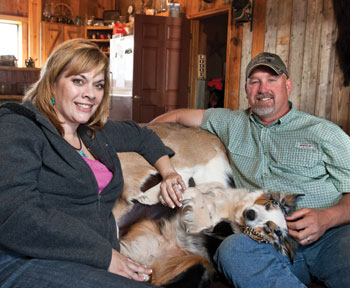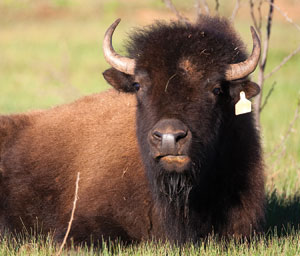Hunters at Dos Plumas Hunting Ranch never pay a trophy fee.
“The last thing we want going through the hunter’s mind when they pull the trigger is ‘how much is this going to cost me?’ We want our customers to have a great hunt at a fair price,” says ranch owner Allen Williams, who calls Dos Plumas “the working man’s ranch.”
He and his wife, Lori, understand that not everybody can afford to pay steep hunting fees. After all, it was just a few years ago that they were working at jobs in town themselves, trying to figure out how they could buy a ranch and make it pay.

Discussing the day’s work in front of the rustic bunkhouse at Dos Plumas Ranch
Photos by Russell Graves
A lifelong hunter and former outfitter, Allen had visited a high-fenced deer ranch about 20 years ago and had hunted on numerous properties. “I always had the idea in the back of my mind that I could make a hunting business work,” he says. But the couple didn’t set out to own a hunting ranch, specifically.
“We didn’t think it was even possible,” says Allen, as he slowly drives over the ranch, which is located half an hour northwest of Abilene, Texas. “We were living in Cleburne (Texas), and I was working for the postal service, when we decided that we’d like to go into business for ourselves and buy a ranch.”
Finding the Perfect Property
After looking at dozens of properties for sale, the couple moved west from the Dallas metroplex to make the property search easier. Lori first took a job in San Angelo, Texas, while Allen worked in the town of Snyder. Because of the distance between their jobs, they lived for a while in a small trailer on a quail lease near Colorado City, midway between their jobs. The time they spent living in the small quarters allowed them to focus on their priorities and property needs.

Lori and Allen Williams with their Australian shepherd, Annie
Photo by
“We had a real estate agent who was patient and took the time to find us the right place,” says Allen. “At first though, it really didn’t click,” he explains. “I thought, ‘we can look at every ranch in the world, but there is no way we can afford a place based on our jobs and the amount of money we make.’ Turns out I was wrong.”
Six years ago, Allen and Lori met with professionals at the Capital Farm Credit branch in Snyder. According to the Williamses, the Capital staff’s knowledge and expertise proved to be an asset from the start.
“We went in with the mindset that we just couldn’t afford a ranch,” Allen confides. “After we talked to them, they showed us not only that we could afford it, but how much financial sense it would make to operate our own hunting business.”
Phil Peabody, branch manager of Capital’s Snyder branch, says the couple came to his office with an open mind and a solid plan for how they wanted to proceed.
“Allen is a great client, because he thinks outside of the box,” says Peabody. “For him, land has many different uses, and he constantly looks for opportunities to put his land to work. That means anything from bringing in different types of game to farming. The ranch is his life, and he is dedicated to the responsible, active production of everything the land has to offer.”

Photo by Russell Graves
Developing a Business
In October 2004, Capital Farm Credit financed the purchase of the unimproved acreage that became Dos Plumas (Spanish for two feathers). Since the initial land purchase, the Williamses have continued to improve the land and develop the ranch. Two years after the land acquisition, Capital Farm Credit financed the construction of a home and bunkhouse complex. Initially, the hunters’ sleeping quarters were part of Allen and Lori’s home, but after a while, the couple decided it would be better to have a detached bunkhouse. In 2007, a rustically inspired, 1,500-square-foot, two-story lodge was constructed to house visiting hunters.
“We try to take on a major improvement project each year,” says Allen. “Phil is a great guy to work with and really shares our vision of what we’re trying to accomplish.” Besides building the main house and bunkhouse, the couple has added an outdoor cooking pavilion, spacious decks and a big storage barn with game processing facilities. They also have re-fenced much of the ranch.
Easing his pickup to a stop, Allen points into the scrub. “Look there,” he says in a half whisper. Peering back at the truck through the mesquite trees is a group of scimitar-horned oryx. Their presence contrasts with what you’d normally see in the open brush and grassland ecosystem of the Texas Rolling Plains, but that’s according to plan.
Year-Round Hunting
Allen and Lori work hard to make Dos Plumas a year-round destination that caters to people who may not have the luxury to take time off work during deer- and turkey-hunting seasons. In addition, they want to provide their service to people who perhaps can’t afford a more expensive hunt. As such, their business plan called for high-fencing much of their acreage and stocking the land with animals like the oryx, as well as fallow deer, blackbuck antelopes, axis deer and other exotics. They chose exotic wildlife, because the species are unencumbered by bag limits, and hunters can pursue them year-round. Of course, feral pigs and varmints are available for year-round hunting, as well.

scimitar-horned oryx
Photo by Russell Graves
A short time later, Allen stops the truck again, this time so he and Lori can talk with a couple of hunters visiting the ranch.
“Any luck?” Allen quizzes them.
“Not yet, but we’re having a great time,” one of the hunters tells the pair. The banter bounces back and forth for a couple of minutes, until the hunters say goodbye and fade into the brush. Driving away, Allen says their sentiment is shared by most of his hunters — they love the Dos Plumas experience.
Indeed, a testimonial on the ranch’s website seconds the comment. “You treated us strangers as if we were family, and that in itself is a rarity these days, with everyone in the business more concerned about the money end of it versus the good time had by their customers,” the satisfied client wrote.
An Experience for Every Budget
“We really care if people have a good time,” says Lori. “Part of making sure that people have a good time is offering them an experience that fits their budget. If they want me to cook for them, then we can help them. If all a group needs is a place to stay and hunt, then we’re able to accommodate a budget hunter as well.”

a buffalo on the Dos Plumas Ranch
Photo by Russell Graves
“We really want to be the working man’s hunting ranch,” Allen interjects.
They must be doing something right. According to Allen, Dos Plumas hosted 600 hunters last year, and their business has proved to be recession-proof. According to Peabody, that’s because Dos Plumas doesn’t try to be something it’s not.
“Dos Plumas is a strong business, because it is authentic,” Peabody explains. “Dos Plumas isn’t necessarily a name or a place on the map — it’s an experience. The experience is authentic, because Allen and Lori live it every day. I think customers appreciate that level of genuine love that they have for the ranch.”
Peabody’s assessment suits the Williamses just fine.
“We had every reason to believe that our chosen lifestyle wouldn’t work,” says Allen. “People told us that we were crazy for giving up stable jobs to pursue this dream. After we made the leap and started Dos Plumas, everything just fell into place.”
From the backseat, Lori nods in agreement. “Our success has definitely been a God thing...,” she says.
– Russell Graves
Allen Williams’ Tips for Turkey Hunting
“Ninety-five percent of what I know about hunting, I’ve learned through experience,” says Allen Williams, owner of Dos Plumas Hunting Ranch. And that includes hundreds of hours of out-smarting and out-waiting wild turkeys. Below, Williams offers seven tips for turkey hunters.
- Sit as still as possible. Turkeys are wary of any movement.
- Wear camouflage from head to toe, including over the face and hands.
- Be patient — patience is critical when hunting turkeys. After the turkey gobbles for a long period, it’s often quiet while it waits to make sure the situation is safe. That doesn’t mean it has left the area.
- If you are new to turkey hunting, start off with a friction call. Keep your calls simple until you become more experienced.
- Know the range of your weapon. Make sure that the turkey is as close as possible before taking your shot.
- Avoid hunting on a windy day. The turkeys can’t hear you call on a windy day, and they won’t gobble.
- Beware of predators. If the turkeys are not gobbling in an area and at a time when conditions for the birds are right, it could be due to predators in the vicinity. Test this option by staying still and calling every 30 minutes for three hours.
Talking Turkey
A Perspective by Suzanne Labry
The wild turkey is native to the Americas, but by the 1930s, wild turkeys were almost extinct, due to over-hunting and habitat destruction. Conservation efforts began in 1937, with the Federal Aid in Wildlife Restoration Act, and were so successful that currently the nation’s wild turkey population is estimated to exceed 7 million.
A wild turkey has some distinctively odd features, such as “caruncles” and “snoods.” As befits their peculiar sound, all these terms refer to fleshy protuberances. A snood hangs down over a turkey’s bill and — how cool is this? — the turkey can extend or contract its snood at will. Both hens and toms have snoods, and people who know about such things speculate that the snood’s purpose has to do with physical attraction, as in, “Hey, Baby, nice-looking snood!”
Baby turkeys, called poults, are independent little guys. They have to be. The mother will feed her chicks (which can number from four to 15) for just a few days, after which they’re pretty much on their own. Toms assume no role in raising their offspring. They’re probably too busy admiring their own snoods.
Seriously though, male turkeys have a lot to be proud of, as they are the ones with the fabulous tail feathers that fan out and a showy beard that can be as long as nine inches. What’s more, a tom can change the color of his head to different shades of blue and the color of the dewlap under his chin from red to white. Sometimes his gobble can be heard a mile away.
Both males and females can sprint up to 18 miles per hour. Wild turkeys run more often than they fly, but when they do fly, they can take off like a helicopter and can reach speeds exceeding 50 miles per hour. They fly straight ahead and fairly low to the ground.
Wild turkeys eat nuts, seeds, fruits, berries and insects. They won’t pass up a lizard or snake either. In turn, wild turkeys, particularly the eggs and poults, are prey for all sorts of predators. Compared to their Thanksgiving counterparts, the wild species is svelte, with females averaging 8 pounds and males averaging 18.
Don’t paint the wild gobbler and the domestic turkey with the same brush. Wild turkeys differ intellectually and athletically — and any bird that can change the color of its head or retract something called a snood, at will, certainly has my attention.